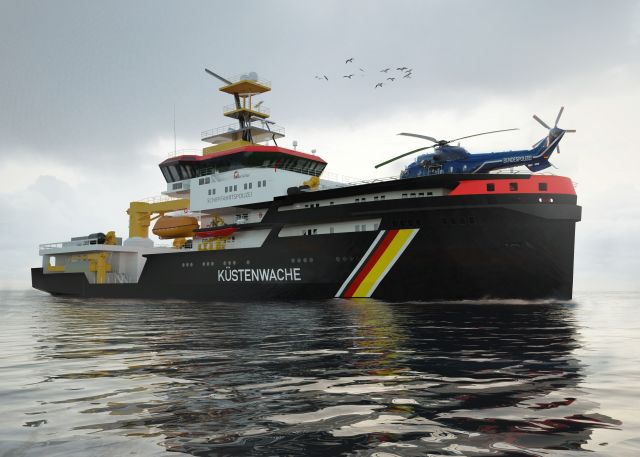
The German Federal Administration of Waterways and Navigation has ordered two special LNG-electric hybrid ships at the Abeking & Rasmussen shipyard in Lemwerder (Lower Saxony), with a third option by 2020, prepared to provide assistance in the event of accidents, fires or ships unable to maneuver. Propulsion will be ensured by Rolls Royce engines.
The long-awaited announcement followed the decision to adapt the plans of the new government ships to the use of LNG rather than to Diesel-electric systems, as foreseen in the original tender. The new design was carried out by the Naval Technology Division of the Federal Waterways Engineering and Research Institute.
These ships follow the Federal Government's first LNG maritime project, the research ship Atair II - the world's first owned by a governmental organization - under construction at the Fassmer shipyard in Berne, Germany, for the Federal Maritime Agency and Hydrographic whose launch is expected by 2020 (here the news of ConferenzaGNL in 2017).
The two new emergency ships, whose names have not yet been announced, will be 95 meters long and 19.5 meters wide, will enter service in 2023 and 2024 and will replace the two today in service in the North Sea and the Baltic : the 56.1 m Scharhörn, built in 1974, and the 80.4 m Mellum, built in 1984.
In the event of an emergency, the new ships will be able to exceed 15 knots and therefore intervene in a short time where necessary; they will also be equipped with a towing force of 145 tons (more than double that of a normal tugboat), chemical tanks, as well as equipment for the recovery (skimmer) of oil from the sea surface, separation and storage.
Both units will use a mixed natural gas-electricity propulsion system based on four Rolls-Royce Bergen medium-speed B36 engines: 45L6AG, each with a power of 3,600 kW. An environmental system protection device guarantees the engines to remain operational even in the case of air contamination caused by explosive or toxic gases, for example, following an accident in a tanker ship.
Enak Ferlemann, Member of Parliament and Secretary of State at the Federal Ministry of Transport and Digital Infrastructure, said: "With these new ships powered by LNG we simultaneously guarantee maximum safety and the best environmental standards in high-tech shipbuilding, and have obtained the Blue Angel environmental certificate, in force since 1978 ".
Blue Angel is the ecological label of the German federal government that sets high standards, continuously updated, for the design of environmentally friendly products and is considered a reliable guide in the last 40 years for a more sustainable consumption.
The Atair II will replace the original Atair research ship, which was introduced into service in 1987, and will carry out hydrographic surveys and wreck search operations, as well as marine environmental observations in the North Sea and the Baltic Sea. It will also carry out technical tests on navigation and radar equipment.
The ship is 74 meters long, about 17 meters wide with a draft of 5 meters and will provide accommodation for 18 crew members and 15 researchers, with a large working deck that offers 200 m² of space to accommodate a wide range of equipment and systems, including laboratories, an air pollution measurement station, a working crane and a scroll bar for geological activities on the seabed.
The work deck will also house containers and extensive diving equipment, as well as a diving room to support research activities. The ship will also be equipped with a hydrographic survey suite with multi / single beam echo sounders, two traditional sonar and one lateral scan sonar, a bottom profiling system for hydrographic research and wreck search.
It will also be equipped with a dynamic positioning system (DP), position reference systems, integrated bridge solutions, maritime broadband camera systems and maritime CCTV, launch and recovery systems, propulsion control as well as automatic navigation systems.
The propulsion system will integrate two six-cylinder Wärtsilä 20DF engines, two exhaust gas cleaning systems and a fuel storage, supply and control system. In addition to LNG, engines can use conventional liquid marine fuels such as light and heavy fuel oil or biofuels, switching from one fuel to another without loss of power and speed. The plant will generate a maximum power of 1,110 kW.
Source: BSA - Maritime Journal – Rolls-Royce
 EN
EN  it
it

